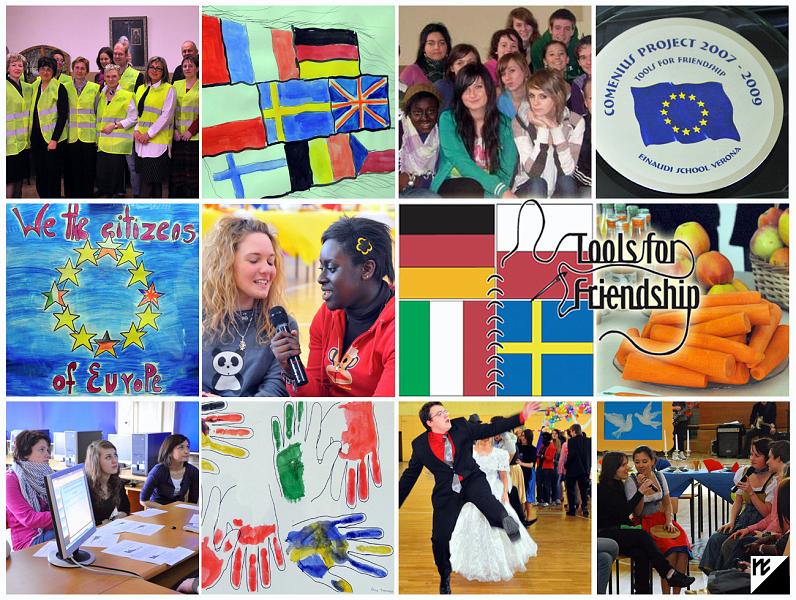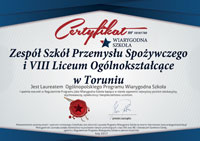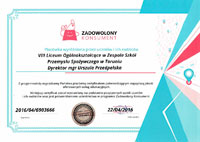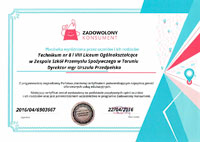
The third year of Cultural Behaviour: Tools for Friendship has come to an end. The last meeting took place in March (19th-24th) in Torun and the countries participating were Sweden, Italy and Germany.
The programme of the meeting included visits to Gingerbread Museum, Planetarium, the Old Town and a carrot-processing company called MARWIT. Apart from that, there were plenty of other activities such as interactive and hands-on experiments in Orbitarium, preparing PowerPoint presentations on the following topics: “The attitude of the young towards current issues such as smoking and taking drugs.” and “We, the citizens of Europe: do you see yourself as a EU citizen or would you rather keep your political/social/regional identity?”
The students prepared and then greatly enjoyed a performance showing their national stereotypes “We, the Citizens of Europe.” while the teachers kindly agreed to be the jury of the 4th Regional Language Contest “Poliglota w Liceum.”
The time passed extremely quickly and we all enjoyed all the activities, going out together, getting to know each other.
The ice was definitely broken.
Comenius Project Team
The meeting for ` Tools for friendship` meeting was fairly curious experience which let me overcome language barriers and also to get to know really cool people and their habits, traditions and approach which we shared together. We prepared a performance about stereotypes and presentation about taking drugs and smoking that allowed me know prohibitions and injunctions in the countries of the European Union. Our free time was always filled with the entertainment so that we could get to know each other better. In my view, such exchange should be organized more frequently. Of course now we are in email contact!
Ola Murawska
Last "Tools for friendship" meeting allowed me to get to know some incredibly interesting people and diverse cultures. We worked together at school, where we prepared a performance about stereotypes and made powerpoint presentations about smoking and taking drugs. We also managed to observe and experience our Polish and Torun heritage - in all possible ways! We cooked gingerbread cookies together, had some hands-on experience in Obserwatorium abut also played quite a bit of ten-pin bowling and other games. It was a great experience. Now I have an email contact with new friends and we are planning unofficial meeting in July. GREAT!
Wojtek Osłowski

A VISIT TO SWEDEN
FALKOPING: 16.10-21.10.2008
Between 16th-21st October 2008 there was a visit to Falkoping, Sweden we all participated in a meeting with other students and teachers from Germany and Italy. The host country was Sweden, which we all thoroughly enjoyed.
The teachers that took part in this exchange were: Monika Czepukojć (Maths & IT) Krzysztof Bartoszyński (History, Civic Studies), Beata Trapnell (English). The students were: Żaneta Gościej, Dorota Wierzbicka and Wojciech Osłowski.
The students and teachers took part in different activities prepared for us all by the Swedes. We discussed GENDER ISSUES, THE CHALLENGES OF COMING OF AGE and THE SITUATION OF HOMESEXUALS in all countries. We had a chance to get to know attitudes of other nations and it gave us a chance to understand each other better.
Another important point of our trip was to continue the project: FROM THE FIELD ONTO THE TABLE. The Swedish delegates showed us multimedia presentations on Dairy Products. It was fascinating to find out how dairy products are manufactures, how the cows are kept and bred and what technologies are used in the production of dairies.
We also thought about the future meeting in Torun and we decided to prepare presentations on the following topics:
a) We, the citizens of Europe: do you see yourself as a EU citizen or would you rather keep your political/social/regional identity?
b) The attitude of the young towards current issues such as smoking and taking drugs (each country’s law and regulations versus the EU directives).
It was an excellent stay – we thoroughly enjoyed Swedish hospitality, friendship and hope to see everybody soon in Torun.
Beata Trapnell
Monika Czepukojć
Krzysztof Bartoszyński
Żaneta Gościej
Dorota Wierzbicka
Wojciech Osłowski.

Here are the most popular stereotypes of Poles and Poland. However they happen to be hugely exaggerated, especially by those who want to ridicule the image of Poland.
First stereotype: Polish people do not speak foreign languages
In some ways it is true that it is not Polands best feature. Some statistics say that only 8 percent of Poles speak fluently one foreign language. However, the situation is changing and the younger generations know the basics of English. Adults and elderly people speak a little Russian because it used to be the only foreign language at school in communist Poland (besides Latin) which was taught to students. Nowadays, learning foreign languages has become a trend in Poland. Language schools and university courses are full of people who would like to study foreign languages and use them in practice.
Second stereotype: Poles never smile, but complain a lot
Once more there is a grain of truth in this statement due to the fact that for many years Poles lived in a communist system which led to lack of basic goods forms of suppression (censorship, propaganda). As the system was so oppressive Poles learnt to complain and be constantly dissatisfied with the situation. Nevertheless, the same system developed a kind of sharp and witty sense of humor which was shown in cabarets and comedies.
With the change of systems a big group of Poles who keep complaining still exists, especially when it comes to giving pessimistic opinions about the benefits from joining the EU. On the other hand, young people are more similar to their Western European peers for they dont complain, and they smile a lot.
Third stereotype: Poles are intolerant
Poland used to be a multinational country where citizens generally learned how to accept and respect the beliefs of other people. Lots of foreigners used to immigrate to Poland because the country was named as a tolerant one. Nowadays, most of them come from poor African or Asian countries, former Yugoslavia and the Soviet bloc. It is not a huge problem to get a visa to stay in Poland if you prove that you cant possibly live in your country because of political or economical problems. Moreover, refugees are legally free to keep their own culture, traditions and religion.
Fourth stereotype: Poles use too much alcohol
Drinking alcohol is one of the favorite pastimes in Poland. In the times of monarchy the most common pattern of any kind of gatherings for people was to celebrate according to slogan eat, drink and loosen your belt. This way of spending time is still very popular in Poland. However, the culture of drinking has changed very much. Now, Poles often go to bars and pubs to meet friends. The traditional alcoholic drink vodka is now being replaced with beer and high-quality liquors.
Fifth stereotype: Poland is a small country somewhere in the East of Europe
Unfortunately, many people from outside Europe still do not known much about Poland especially about its location on the map of the world and its geographical features. Geographically, the center of Europe is in Poland, near Warsaw. Poland is situated in the very center of Europe, not in the East. Such an idea probably was born after the WW II when Poland was made to be one of the inferior countries to the Soviet Union. What is more Poland is one of the bigger countries in Europe, its size comparably as big as New Mexico state.
Adapted from:
http://www.staypoland.com/poland-stereotypes.htm
http://culture.polishsite.us/articles/art1fr.htm
Stereotypes about Poland - what your countrymen think about Poland in general and Polish people?
Opinions from the Internet
Wroblewskiwrobel:
Some people say that (our) polish girls are among the most beautiful women in the world. Thats quite a nice stereotype I think and sometimes I was surprised to hear that poles are well educated. (thanks to communistic education system)
Mary:
I've met a few people from Poland. They were intelligent and funny and had clear goals.
Brian:
Poles are funny. They have a great sense of humour. They get English jokes far more better than anybody else. I love it.
Anonymous:
I was working in Poland as a guide part time. A tourist from the USA, a military officer stationed in Austria said, "I did not have an idea that Poland is bigger than Austria. I thought than Austria was bigger than Poland".
On a couple of occasions when asked, "where I am from?" I answered "from Poland" then people confuse Poland with Holland. I heard several times: "Wow, Holland, I was there!". When I try to correct, "I am not from Holland but from Poland" then, there is a silence.
Steph:
I am Canadian.. I don't really have a stereotype about Polish people.
I used to work for a Polish guy - he seemed alright. I don't think he knew my name though and I worked for him for nearly 3 years..
The only country I tend to have stereotypes for is Americans.. :)
Dutchboy:
Well, Dutch employers see them as hard workers, which from what I have seen on construction sites around my country is true. A lot of Dutch people still look upon Poles as thieves, and people who take their jobs away by working for less money.
Muley Bob
I don't think people in my generation still have that idea about the Polish. Really I don't have any stereotypes about them. The world has changed so much since the fall of communism in Europe, I think all the old stereotypes are out the window.
Cited from:
http://answers.yahoo.com/question/index?qid=20070907042844AA0MDEs
http://culture.polishsite.us/articles/art1fr.htm
http://www.odyssei.com/forum/index.php?showtopic=91556
Stereotypes always tend to have some truth mixed in with a few generalisations and a bit of exaggeration. Here a small list that Italians usually do in their life.
The typically Italian man has dark eyes and a dark complexion, with black hair. He is very passionate and lazy and he works in factory or into an office. The typical Italian woman has a round shape. She is very charming and she works as housewife.
The Italians usually live in flats in the city. They pay a rent once a month because a house of ownership costs too much. They work in factory or in office as employee and once a month they receive a salary. Every day the Italians dink a cup of Italian coffee around ten o’clock, they read “ Il Messaggero”, “L’Arena”, “Corriere dello Sport” and “La Repubblica” newspapers and magazines like “Novella 2000”, “Chi” and others like this.

They usually have fish on Tuesdays and on Fridays, while the others days, they eat meat and soup. At lunch instead they always have pasta and drink Italian white wine. After work, the typical Italian man goes to the gym or practises sport. The lazy Italian man instead usually goes to bar; he likes smoke cigarettes and a very few people smoke a cigar and he usually watches the TV sat in his armchair.

The Italians watch RAI television, Mediaset channel and Sky and they love watch the sport matches on TV. During the evening they usually watch adventure films, documentaries and quiz programmes with a good Italian beer.
In every family there are 3 or 4 persons because the Italians don’t love big families but there’s always a dog or a cat because they are a little bit “mammon”. During the free time the Italians love go to the cinema with the family, to walk to the mountains, eat in small restaurants and for the women talk on the phone to hers friends about cakes and Italian recipes.
About guys, they love going out in pubs or in discos on Fridays and on Saturdays night, skiing and play football and for the girls and women in general they love hanging out in the city looking the showcases. On Sundays afternoon they usually go to the cinema with friends and during evening they have pizza. The Italians guys study at High school or at the university. They love wear well themselves and to take care of their aspect. They like politics but don’t trust very much in political and they don’t love foreign languages.
Finally, there is one detail that unites all the Italians:
-THEY LOVE THEIR MAMAS-
Righetto Michele
Spaghetti and pasta in general are sacred. You cannot take pasta away from an Italian meal otherwise it won't be complete. A typical Italian meal usually includes:
1.Starter (primo): pasta
2.Main course (secondo): fish or meat with salad
3.Fruit or dessert (dolce)
4.Coffee

Here we start running into the first problems, there are some big regional differences in Italy, so you might find risotto replacing pasta in some places!

A good meal should always be shared with someone else. It is a way to share conversation and jokes, forget about work for a couple of hours and enjoy life. Be assured, an Italian will always find the time to eat properly. The Mafia is real: we are not proud of it but it does exists, especially in the South and the island of Sicily. Obviously, not every Italian is a Mafioso and most will feel offended and insulted if you use the term, even when if you mean it as a joke. The most important element of communication are the gestures: the way we move our hands, hold our heads, move our shoulders, our facial expressions, as well as the way we use our eyes and mouths to make ourselves understood. We simply cannot talk without our hands. If they are busy doing something else, we start moving shoulders or other parts of the body for emphasis. Italians speak very loudly in public whether on the bus, in the street or on the phone. We like to travel a lot, but do not speak many foreign languages - maybe because we trust body language more than words. We do enjoy romance and maybe the stereotype of the Italian romantic lover is not completely dead. An Italian guy will never let a girl go home unescorted. Also, the macho ideal is still alive and well in Italian culture.

We are also fashion victims: you can recognize Italians by the way they dress from the head to feet. We usually dress strictly black Dolce & Gabbana sunglasses; Calvin Klein boxers; Levi's jeans; Gucci handbags; tanned skin all year long; perfect make up). We will dress stylishly for every possible occasion. You won't ever see an Italian wearing sporting short pants combined with long socks: it's simply against our fashion rules (let alone our sense of style)! We are chaotic. Nothing in Italy is well organized or easy-to-use. You have to fight to get the smallest scrap of information. Don't be surprised to see Italians fighting to get into the buses or jumping the queue to be served first at the coffee bar. Italy’s slow-moving and stressful bureaucracy has made us more pushy and resourceful.
Misja szkoły
 Misją szkoły jest wspieranie wszechstronnego rozwoju uczniów na miarę ich potrzeb i możliwości,
Misją szkoły jest wspieranie wszechstronnego rozwoju uczniów na miarę ich potrzeb i możliwości,
tworzenie szkoły bezpiecznej i przyjaznej oraz dobrze przygotowującej ich do dalszego kształcenia
Szkolne projekty Erasmus+, POWER i FERS

Projekt Nr 2023-1-PL01-KA122-VET- 000114679 "Europejskie praktyki drogą do sukcesu"
Projekt Nr 2022-1-PL01-KA122-VET-000078769 "Zagraniczne praktyki kluczem do sukcesu zawodowego"
Projekt Nr 2021-2-PL01-KA122-SCH-000041958 "Nowoczesna kadra na europejskim poziomie"
Projekt Nr 2019-1-PL01-KA101-063384 "Doskonalimy kompetencje zawodowe na europejskim poziomie"
Projekt Nr 2019-1-PL01-KA102-063142 "Europejska praktyka szansą na sukces zawodowy"
Wizja
ZSPS i VIII LO, to szkoła zarządzająca wiedzą, otwarta na środowisko lokalne, aktywnie współpracująca z rodzicami, gdzie każdy uczeń z dumą mówi: "to moja szkoła".
W latach 2016-2021 zamierzamy budować szkołę, która umie sobie poradzić z nowymi wyzwaniami, celami, priorytetami edukacyjnymi, potrzebami, aspiracjami i oczekiwaniami uczniów, rodziców i nauczycieli.
Koncepcja funkcjonowania i rozwoju
Zespołu Szkół Przemysłu Spożywczego
i VIII Liceum Ogólnokształcącego w Toruniu
w latach 2022-2027
Moja wizja
ZSPS i VIII LO to szkoła zarządzająca wiedzą, otwarta na środowisko
lokalne, aktywnie współpracująca z rodzicami, gdzie każdy uczeń z dumą mówi:
„to moja szkoła”.
W latach 2022 – 2027 zamierzam nadal budować szkołę, która umie sobie poradzić ze zmianami i nie narzeka na to, że te zmiany są, bo świat się zmienił, a wraz z nim edukacyjne priorytety, cele, potrzeby, a także uczniowie, rodzice, ich aspiracje i oczekiwania.
Obecnie liczą się:
- umiejętności (np. cyfrowe, komunikowania się, współpracy, a także uczenia się i zarządzania informacją, bycia źródłem inspiracji),
- opieka psychologiczno-pedagogiczna,
- otwartość szkoły jako instytucji (uczeń ma możliwość wyboru profilu nauczania),
- dostęp do informacji,
- poczucie bezpieczeństwa, którego podstawą jest dobra atmosfera i dobre relacje z całą społecznością szkolną,
- możliwość współtworzenia szkoły,
- nowoczesne technologie, multimedia.
Te priorytety wraz z reformą oświaty, nowoczesne technologie oraz talenty społeczności szkolnej wyznaczać będą kierunek rozwoju naszej szkoły przy zachowaniu dotychczasowej struktury wewnętrznej i możliwości szybkiego dostosowania się do sytuacji na rynku pracy.
Główne kierunki moich działań zawarłam w sześciu podstawowych obszarach:
- Demokratyczne zarządzanie szkołą.
- Kształcenie ukierunkowane na rozwój ucznia i nauczyciela.
- Wychowanie w szkole.
- Bezpieczeństwo w szkole.
- Działania administracyjno-gospodarcze.
- Pozyskiwanie środków finansowych na rozwój.











